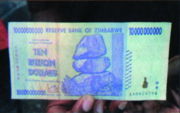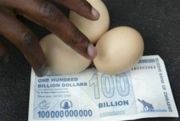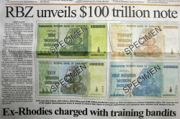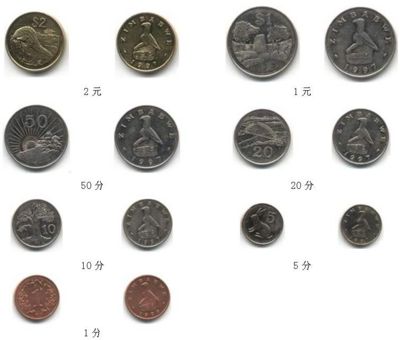辛巴威元
出自 MBA智库百科(https://wiki.mbalib.com/)
辛巴威元(Zimbabwe Dollar 原符號:ZIM.$ 標準符號:ZWD)
目錄 |
2009年04月12日BBC中文網消息,辛巴威政府決定,在未來一年時間里正式暫停使用本國貨幣。此前,辛巴威貨幣事實上已經停止在市面上流通。[1]
2009年03月18日辛巴威新任財政部長滕達伊·比蒂發表言論說,本國貨幣辛巴威元的“死亡”已成現實,從2008年10月份開始津元就在垂死掙扎,現在已不再流通。[2]
2008年12月19日據德新社報道,辛巴威央行19日發佈公告說,與100億津元新鈔同時發行的還有面額為10億津元和50億津元的新鈔。[3]
2008年12月13日據新加坡《聯合早報》報道,辛巴威再次發行新鈔票,新鈔面值是5億辛巴威元,乍看之下有如天文數字,但實值只有10美元。[4]
辛巴威央行行長戈諾透過國營《先鋒報》發佈聲明,宣稱發行新鈔的目的,是為了方便消費者使用。聲明說,面額1000億津元的新鈔於21日開始在市面上流通。
辛巴威從2008年05月06日起開始發行當前世界上最大面額的鈔票,分1億津元(約人民幣2.3萬元)和2.5億津元(約人民幣5.8萬元,如圖)兩種。
這是辛巴威儲備銀行繼今年初發行1000萬面額紙幣以來,第三次發行超大面額鈔票。
辛巴威央行行長說,發行這兩種新面額的鈔票是因為國家煙草、棉花等行業以及銀行系統需要更多的現金來促進工商業的發展。
津儲備銀行今年以來已經連續三次發行新貨幣,最近一次是在今年4月初,發行了2500萬和5000萬面額的兩種新幣。
但是,由於辛巴威通貨膨脹率迅速上漲,貨幣急劇貶值,新發行的貨幣很快就變得一錢不值,迫使央行不斷發行更大面額的鈔票。
The revalued Zimbabwean dollar (ISO 4217 code ZWD) has been the currency of Zimbabwe since August 2006, when it replaced the old Zimbabwean dollar (ZWD) at a rate of 1,000 old ZWD = 1 ZWD (revalued). The ISO originally assigned a new currency code of 'ZWN' to this redenominated currency, but the Reserve Bank of Zimbabwe could not deal with a currency change. Therefore the currency code remains 'ZWD'. 1ZWD=100 cents
It is normally abbreviated with the dollar sign $, or alternatively Z$ to distinguish it from other dollar-denominated currencies. It is divided into 100 cents.
Thirteen new bearer cheques were released on 1 August 2006 in denominations from 1 revalued cent to $100,000 (revalued).
History
The old Zimbabwean dollar replaced the Rhodesian dollar at par, which in turn had been adopted in 1970 as a decimalization replacement of the Rhodesian pound at a rate of 2 Rhodesian dollars to 1 Rhodesian pound (R$ 0.71 = US$ 1.00). At the time of independence in 1980, one Zimbabwean dollar was still worth more than the US dollar (ZWD 0.68 = USD 1.00), but the currency's value has eroded rapidly over the years. On 26 July 2006 the parallel market value of the Zimbabwean dollar fell to one million to the British pound.
The Zimbabwean dollar was redenominated on 1 August 2006 at the rate of 1 revalued dollar = 1000 old dollars. The subunit is still cent, 1/100 of a revalued dollar. Also on 1 August 2006 the Government of Zimbabwe devalued the Zimbabwean dollar by 60% vs. the US dollar (see exchange rate history table below), from 101,000 old dollars (101 revalued) to 250 revalued dollars.
Inflation
Rampant inflation and the collapse of the economy have severely devalued the currency, with many organizations using the US dollar, the euro, the pound sterling, or the South African rand instead.
Early in the 21st century Zimbabwe started to experience hyperinflation. Inflation reached 624% in early 2004, then fell back to low triple digits before surging to 1,281.1% in December 2006. If policies do not change, the IMF has predicted an inflation rate of over 4000% for the year 2007.
The year 2007 has started badly as inflation reached another record high of 1729.9% in February. On March 19th, the IMF predicted that inflation will most likely hit 5,000% this year.
Currency Revaluation of 2006 (New Zimbabwe Dollar)
In October 2005, the head of the Reserve Bank of Zimbabwe, Dr. Gideon Gono, announced "Zimbabwe will have a new currency next year." New banknotes and coins were to replace the then current Zimbabwean dollar. Gono did not provide a name for this new currency.
In June 2006, Deputy Finance Minister David Chapfika stated that Zimbabwe had to achieve macroeconomic stability (i.e., double digit inflation) before any new currency was introduced.
On 31 July 2006, the Reserve Bank of Zimbabwe revalued the Zimbabwe dollar by one thousand to one. Thirteen new bearer cheques were issued and people were only given 21 days to exchange the old bearer cheques.At the same time, the Zimbabwean dollar was devalued by 60% and the new exchange rate set at 250 revalued dollars per 1 U.S. dollar.
The problem-ridden revaluation campaign, which Gideon Gono named "Operation Sunrise" was completed on 21 August 2006. It was estimated that some ten trillion old Zimbabwe dollars, about 22% of the money supply, were not redeemed during this redemption period (a nice windfall for the Reserve Bank of Zimbabwe).
Other problems included, but were not limited to:
► Behavior by police and youth militias who set up roadblocks and seized currency beyond the daily deposit limits;
► Invasions of businesses and homes to seize cash;
► Shortages of the new bearer cheques (even at banks);
► Refusal of many businesses and people to accept the old bearer cheques;
► Chronic shortages of "small" bills to make change; and
► The rapidity of the change over, particularly for people in remote, rural towns where information on the changes was received too late to exchange their bearer cheques.
Most economists have blasted the move as merely political. They claim that without drastic changes in the policies of the Reserve Bank of Zimbabwe, the zeroes will come back rapidly.
As people panicked to dump their old cash, the revaluation process drove up prices on the Zimbabwean Stock Exchange to levels that, while still below the 1,000% inflation, are the highest returns of any market in the world.
Yet another currency revaluation planned.
On December 12, 2006, Dr. Gono hinted in a memorandum to banks and other financial institutions that he would lay out the next phase of his monetary reforms dubbed Project Sunrise Two when he announces the monetary policy review statement in January 2007. It was not possible to get immediate confirmation from Gono's office whether the memorandum was an advise to banks that he would be launching the new currency in January. But the chief executive officer of one of the country's largest banks said industry players had understood the governor's memo to mean new money would be introduced next month. A possible name appears to be "ivhu", which means "soil" in Shona.
On February 2, 2007, it was revealed that a new (third) dollar would be released "soon", in denominations of $1, $5, $10, $20, $100, $500, and $1,000. The $1 bill has an image of the Victoria Falls and a buffalo, the $5 the Kariba dam wall and an elephant, the $10 agricultural activity and a grain silo, the $20 portrait of a mine site and a mine with a jack hammer, $100 the botanic gardens and the Great Zimbabwe conical tower, the $500 a portrait of a dairy farm. No indications of what will be on the $1,000. However, given that inflation remains in the four digits, these banknotes are likely to remain in storage for the foreseeable future.
In February 2007, the central bank of Zimbabwe declared inflation "illegal", outlawing any raise in prices on certain commodities between March 1 and June 30, 2007. Officials have arrested executives of some Zimbabwean companies for increasing prices on their products. Economists generally suspect that such measures will be ineffective at eliminating the problem in the long term.
Related Currencies
Rhodesia: In 1980 the Zimbabwean dollar replaced the Rhodesian dollar at par.
Bearer Cheques
Bearer Cheques - NEW ZIMBABWE DOLLAR
Following the monetary reform of 1 August 2006 one new Zimbabwe Dollar is worth 1000 old Zimbabwe Dollars.
The banknotes marked ‘CENTS’ were printed on paper that was already in stock. The paper contains a watermark and was previously used to print the 500 Dollar banknotes issued in 2001. This explains the inclusion of a security strip and the number 500 inside the watermark. The cent banknotes are larger then the dollar denominated banknotes, measuring the same size as the old $500 note (154mm x 78mm), whilst the banknotes denominated in dollars are smaller (148mm x 74mm) which is the same size as the old fifty dollar banknote. Like the previous series of bearer cheques, the new series also bears an expiry date





















































































